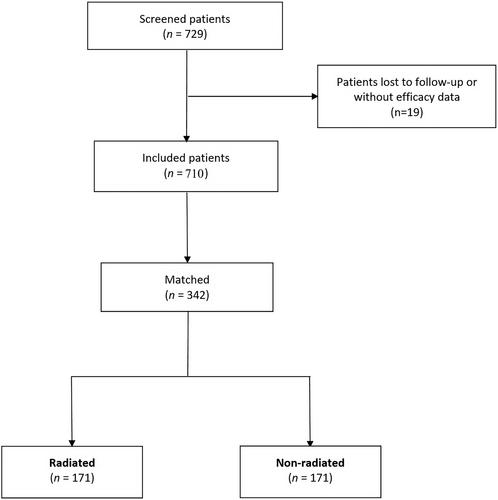The effectiveness of adjustable trans-obturator male system (ATOMS) in radiated patients is reduced: A propensity score-matched analysis
Abstract
Objectives
This study aimed to compare the effectiveness and safety of the adjustable trans-obturator male system (ATOMS®) to treat post-prostatectomy incontinence (PPI) in radiated patients compared with non-radiated patients, using propensity score-matching analysis to enhance the validity of the comparison.
Patients and methods
Consecutive men with PPI treated with silicone-covered scrotal port ATOMS (A.M.I., Feldkirch, Austria) in nine different institutions between 2016 and 2022 were included. Preoperative assessment evaluated 24-h pad usage, urethroscopy and urodynamics, if indicated. Propensity score-matching analysis was based on age, length of follow-up, previous PPI treatment, previous bladder neck stricture, androgen deprivation and pad usage. The primary endpoint was dry rate, defined as no pads post-operatively with a security pad allowed. The secondary endpoints were complications, device removal and self-perceived satisfaction with the Patient Global Impression of Improvement (PGI-I) scale.
Results
Of the 710 included patients, 342 were matched, and the study groups were balanced for the baseline matched variables. The mean baseline 24-h pad was 4.8 in both groups (p = 0.48). The mean follow-up was 27.5 ± 18.6 months, which was also equivalent between groups (p = 0.36). The primary outcome was achieved in 73 (42.7%) radiated patients and in 115 (67.3%) non-radiated patients (p < 0.0001). The mean pad count at the last follow-up was 1.5 and 0.8, respectively (p < 0.0001). There was no significant difference in complications (p = 0.94), but surgical revision and device explant rates were higher (p = 0.03 and p = 0.01, respectively), and the proportion of patients highly satisfied (PGI-I = 1) was lower in the radiated group (p = 0.01). At sensitivity analysis, the study was found to be reasonably robust to hidden bias.
Conclusion
ATOMS implantation significantly outperformed in patients without adjuvant radiation over radiated patients.


 求助内容:
求助内容: 应助结果提醒方式:
应助结果提醒方式:


